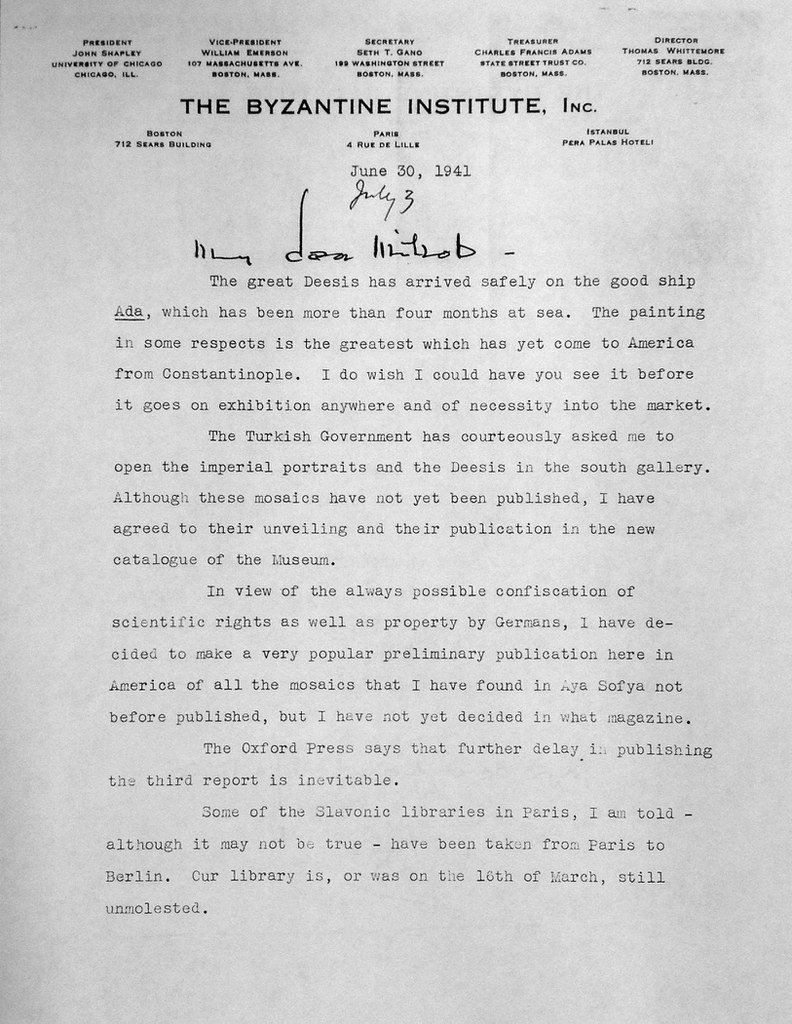[MS.BZ.004-01-01-02-014]
June 30, 1941
July 3
My dear Mildred-
The great Deesis has arrived safely on the good ship Ada, which has been more than four months at sea. The painting in some respects is the greatest which has yet come to America from Constantinople. I do wish I could have you see it before it goes on exhibition anywhere and of necessity into the market.
The Turkish Government has courteously asked me to open the imperial portraits and the Deesis in the south gallery. Although these mosaics have not yet been published, I have agreed to their unveiling and their publication in the new catalogue of the Museum.
In view of the always possible confiscation of scientific rights as well as property by Germans, I have decided to make a very popular preliminary publication here in America of all the mosaics that i have found in Aya Sofya not before published, but I have not yet decided in what magazine.
The Oxford Press says that further delay in publishing the third report is inevitable.
Some of the Slavonic libraries in Paris, I am told - although it may not be true - have been taken from Paris to Berlin. Our library is, or was on the 16th of March, still unmolested.
We have for months been trying to bring two of our collaborators in Paris over to America, but it is still impossible to get permits for them to leave occupied France. That would leave one man in Paris to guard the library and its records. We have one man working in Cairo.
Our effort in reaching these men with money for food in Paris you will understand in exercising all our skill.
I should like very much to come to the West Coast to give some lectures on the mosaics and Byzantine art in general, which could be illustrated with colored moving pictures.
There is a question which face to face I can discuss with you. It is in regard to additions to your coptic collection at Dumbarton Oaks, which could be lifted to a place of unique eminence in this country, but for this I must wait until we can discuss the matter together.
Yours devotion and affection
T.W.
More Exhibit Items

Connick, a leading American stained glass artist of the first half of the 20th century, expresses his amazement upon seeing a film of the mosaics of Hagia Sophia.

Gregory expresses his opinion upon seeing the films shot in 1936 for the first time the following year.

Arne extends an invitation for Whittemore to give two lectures illustrated with films in Sweden.

Roosval expresses how delighted he is that Whittemore will be visiting Stockholm and Upsala to give lectures illustrated with the film.

Bliss expresses her apprehension regarding Whittemore's return to Istanbul, suggesting that he should instead travel around the United States to show "the film" since many people were interested in seeing it.

Whittemore expresses his interest in publishing the uncovered mosaics in Hagia Sophia as soon as possible to prevent German intervention. He discusses publicizing the work of the Byzantine Institute on the West Coast by giving a lecture illustrated with the color films.

Whittemore informs Thacher, Director of Dumbarton Oaks, that he has agreed to show a color film of the work carried out at Hagia Sophia, in response to a request from the Administrative Committee of Dumbarton Oaks.

Whittemore agrees to show color films of the work done at Hagia Sophia at Dumbarton Oaks.

Whittemore proposes a lecture at the University of Rochester, which will be illustrated with color films of the conservation work carried out in Hagia Sophia.

Clark from the Eastman Kodak Company invites Whittemore to give a public lecture illustrated with the color film at the Art Gallery in Rochester, NY.

Thacher, Director of Dumbarton Oaks, asks Whittemore to give a public lecture with films at Dumbarton Oaks.

This short summary published in the proceedings of the 6th Congrès International des Études Byzantines shows that Whittemore presented the work of the Byzantine Institute to the Byzantine scholarly community by means of the color films produced during the cleaning and restoration work at Hagia Sophia.

The Executive Officer of the Society informs Whittemore that a screening of the films at the Annual Meeting in 1950 would not be possible, but proposes to put him on the program for the following year.

Whittemore agrees to show the color film at the American Philosophical Society Annual Meeting in 1951. This screening never took place as Whittemore passed away on June 8, 1950.

Coolidge from the Fogg Art Museum at Harvard University accepts MacDonald's offer for a screening of the Byzantine Institute films.

Marian Hayes, art history professor at Mount Holyoke College and a former student of Whittemore's at New York University, inquires about renting the color film on Hagia Sophia to show it to her students.


